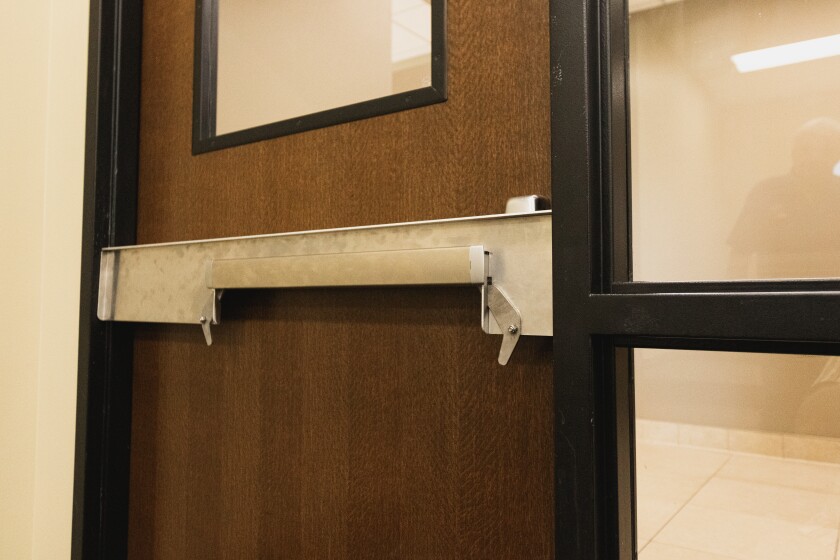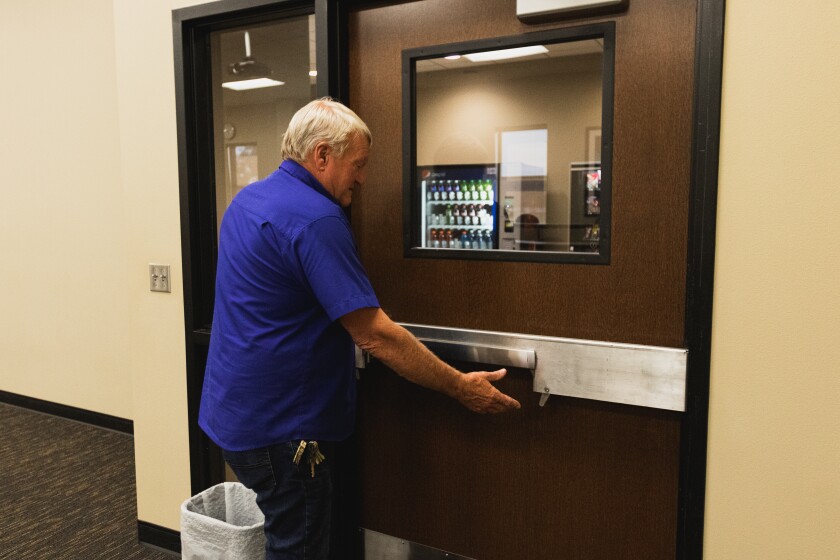MITCHELL — Students from kindergarten to college often take part in safety drills, whether it be how to safely exit a building in the event of a fire or where to find shelter within the school in the event of a tornado.
Unfortunately, school shooting drills are also a reality and necessity in this day and age, when school shootings have become more and more frequent. According to Education Week,
ADVERTISEMENT
Jeff Harris, a custodian at Dakota Wesleyan University, is looking to help get that number closer to zero.
“We had an active shooter training three years ago, and you can key-lock the doors in the building and once they’re shut, they’re locked, but someone could break the window out and reach in and push the push bar,” Harris told the Mitchell Republic. “So I came up with this design. I call it the Threat Stop.”
The custodian and longtime member of the Mitchell Fire and EMS Division is something of an inventor in his spare time, and he’s drawing attention for his latest effort — a device that easily and automatically locks classroom doors to prevent a shooter from gaining access. It’s an idea that came to him when speaking with professors who were worried that a gunman could force their way into a classroom with relative ease if they were so inclined.
The device he came up with is a stainless steel and aluminum bar with a pair of locking latches at the bottom. It can be dropped into place over the push bar on the inside of doors that are commonly found in large buildings, such as schools, nursing homes, hospitals and business offices, making the door nearly impossible to open from the outside.
By securely locking the door, those inside can utilize other shelter-in-place methods to improve chances that a shooter won’t find them.
“If they hear an active shooter is coming, instead of running out of the building and running into the shooter, you can lock down and shut the lights off. If they’re hidden out of sight, the majority of the time (the shooter) will try the door and, if there’s no light and they don’t see anyone, they’ll move on,” Harris said.
He has already received a patent for the prototype version of the device, and he has a patent pending on the upgraded model that improves on the original design. And schools from around the region have already expressed interest in acquiring the device, which Harris said took practically no time at all for him to design.
ADVERTISEMENT
“It came to me really easily. Within an hour I had thought of it. It took another hour to go to Menard’s and walk around and get the materials. I’m just trying to protect people from harm. I wish I didn’t have to make it,” Harris said.
A problem solver
The ability to design devices that solve problems has always come naturally to Harris. As a 30-year veteran of the Mitchell Fire and EMS Division, he designed a type of eyeglasses that features a video camera for use on a specific type of emergency medical calls. He designed a special probe for household freezers to sound an alarm when the cooling unit is failing so that frozen meat and other perishables don’t go bad. Another invention helps keep the shavings from a circular saw from flying in the operator’s face.
“I try to think of a solution,” Harris said of his affinity for helping people through innovation.
It’s all a product of the way his mind works and his desire to help people. It’s what drove him to be a firefighter and emergency medical technician for three decades, and it continues in his new part-time position as custodian at Dakota Wesleyan University, where he has come to embrace the faculty, staff and students as he would his own family.
He is known to encourage students to develop their skills, as he does with a history major who dabbles in art. He buys her art supplies and she, in turn, creates works of art for him. He enjoys meeting students from all over the world, and has even been known to give out hand warmers to students hailing from warmer climates when the South Dakota winter hits in full force.

“They don’t seem to wear warm-enough coats in the wintertime,” Harris chuckled.
Bethany Melroe Lehrman, a chemistry professor at Dakota Wesleyan, was one of the faculty members to help inspire Harris to come up with his latest creation. Harris expressed that he would come up with a lock that would secure the door after she expressed concern about how to deny a shooter access to a classroom.
ADVERTISEMENT
All it took was an offhand remark, and the wheels started turning in Harris’ head, she said.
“After we had the active shooting training here, we (wondered) what we would do in these rooms. And I looked at Jeff and said we were out of luck, we have no way to lock these doors in here,” Melroe Lehrman said. “All I basically said was that, and Jeff is gone and he comes back with an actual device.”
The speed by which he turned a casual comment into an actual product was surprising, but his concern for people on campus, wasn't she said.
“The fact that Jeff cares so much about the students and his coworkers in this building is why he did it. He immediately thought, ‘How do I keep my building safe? How do I keep my people safe?’ One hundred percent that’s the driver behind it. He wants to help people here,” Melroe Lehrman said.
Administrators at Dakota Wesleyan have also acknowledged that Harris has gone above and beyond in his concern for the well-being of people on campus.
“We are so proud of Jeff. He truly represents the spirit of DWU, a place that puts learning into action. He saw a problem and used his expertise to offer a solution that helps communities. We wish him every success with both this and future projects,” Dan Kittle, president of Dakota Wesleyan University, said in a statement.
More ideas to come
Harris is waiting to hear from the United States Patent and Trademark Office about his latest Threat Stop design version, but he has no plans or desire to build or market the device himself. He’s hoping a company in an appropriate industry will eventually purchase the patent and find markets for it around the country.
ADVERTISEMENT
The simplicity — it’s made up of three parts, not counting the few nuts and washers — and the low-cost of manufacture should make it appealing to someone, he said.
“It’s about $75 to build, and if a large university bought hundreds of them that price would go down,” Harris said. “But I don’t want to make them and I don’t want to sell them. I’m at the age, nothing personal, but I don’t want employees. I’d just as soon a company see the potential or need for it. You think of one large city — Chicago or Denver or Atlanta — there has to be millions of doors in just one town.”
He knows there are other designs that perform a similar function out there, and if one of those designs becomes the go-to device for such circumstances, then so be it. He doesn’t care who comes up with the best design or gets the most credit, as long as it does the job it’s supposed to, he said.

Having a company take his idea to the next level will allow him to focus on what he likes to do: come up with new ideas that solve common problems. He has one idea for using UV light to disinfect cash money right inside cash register drawers to cut down on bacteria and the transmission of illness. He has a few other ideas he’s not ready to discuss just yet.
And in a few weeks, he’ll be presenting to Dakota Wesleyan students on the ins and outs of applying for a patent. He hopes it will inspire them to come up with their own ideas and innovate on their own.
It’s a good lesson for them to learn, because you never know where or when inspiration may hit you. Harris knows from experience that it could be at any time.
“I actually came up with another idea this morning. I’m serious,” Harris laughed. “It might not go anywhere, and if it doesn’t, that’s okay. I’m trying to make things better for all humans, make it safer. Not just for kids, but for college students and everyone else.”









